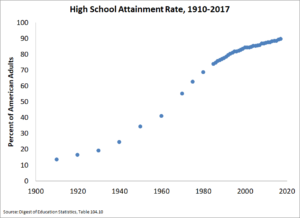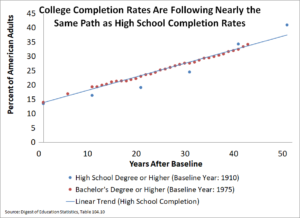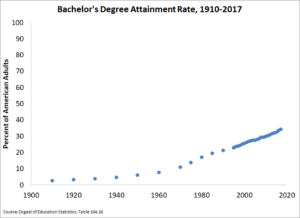In 1950, 34.3 percent of American adults had a high school diploma or higher. Over the next 30 years, that percentage would double.
Today, about the same percentage of adults (34.2 percent) have a bachelor’s degree or higher. Will that percentage double over the next 30 years?
That may seem like a crazy question. College is different than high school, for lots of reasons, not the least of which is that we’ve decided to draw an arbitrary line at 12th grade. After that point, we expect individuals to pay for some or all of their education costs. That arbitrary distinction may be changing, albeit slowly.
But so far at least, high school and college attainment rates are following nearly the same path. The change in the high school attainment rate in the first half of the 1900s looks nearly identical to where we are today in terms of college attainment.
On a grand scale, the high school attainment rate looks like a pretty standard S-curve. After relatively modest gains in the 1910s and 1920s, growth rates started to accelerate in the 1970s and 80s before inevitably slowing down a bit since then:
 If you look at only the left half of the high school attainment graph, that’s pretty much where we are in terms of bachelor’s degree attainment. Just like the early years for high school attainment, the growth in bachelor’s degree attainment was pretty slow for a long time but has picked up in recent decades. The data only go through 2017 so far, but in terms of college attainment gains, the 2010s are on track to be the best decade on record:
If you look at only the left half of the high school attainment graph, that’s pretty much where we are in terms of bachelor’s degree attainment. Just like the early years for high school attainment, the growth in bachelor’s degree attainment was pretty slow for a long time but has picked up in recent decades. The data only go through 2017 so far, but in terms of college attainment gains, the 2010s are on track to be the best decade on record:
In fact, the early stages of the high school and college attainment trends look extremely similar. They’re just a couple generations apart. To show what this looks like, I overlaid the high school attainment rate from 1910-1960 versus the college attainment rate from 1975 to today, and the graph below is the result. The two have a correlation of 0.96, and the college attainment results (the red dots) are tightly hugging the blue trend line representing the change in high school attainment from a couple generations prior. 
As I wrote in 2015, the key question is what happens next. Do the college attainment rates stay on the linear trend they have been on, or do they start to look more like the S-curve path that high school attainment eventually followed?
There are a lot of factors that will answer that question. Mortality and immigration matter here, of course, but so do education policies. In the last half of the twentieth century, we created things like compulsory attendance laws, the GED, and the GI Bill to accelerate our attainment rates, to name just a few contributors. At the high school level, we got better at tracking enrollment and completion rates, and we eventually started holding high schools accountable for graduating their students.
All of these efforts are further behind at the higher education level. It’s an open question whether we’ll make the equivalent policy adjustments in higher education as we did in K-12, but the answers to that challenge matter both to the individuals graduating today and to our broader society going forward.
–Guest post by Chad Aldeman


Very interesting!
Chad – you’ve done so much great writing to point out the pension disasters, by raising uncomfortable questions about the accounting, so I’m curious if that skepticism extends to grad rates.
“The 2010s are on track to be the best decade on record.” I would have thought: “highest on record.” It’s debatable whether higher college grad rates are, in net, a good thing, if a big component is just an arms race on “signaling,” and the cost/benefit for the marginal student remains fuzzy (and changing).
Same with “we eventually started holding high schools accountable for graduating their students.” Some would say “accountable to hand diplomas to kids who didn’t mean any reasonable bar, thereby devaluing the diploma, and wasting resources that might have been used to benefit those marginal students more directly.”